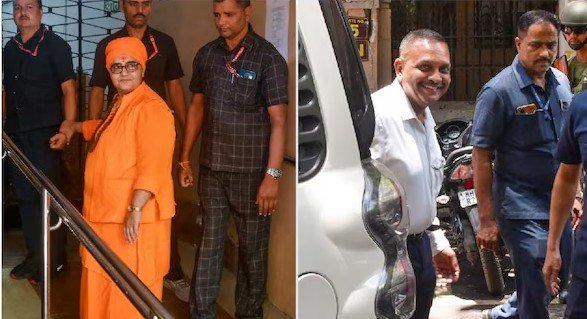In a landmark judgment that marks the end of a 17-year-long legal battle, a special court of the National Investigation Agency (NIA) in Mumbai on Wednesday acquitted all seven accused in the 2008 Malegaon blast case. The verdict brings closure to one of India’s most politically charged and prolonged terrorism trials.
All Seven Walk Free
The seven individuals acquitted include BJP MP Sadhvi Pragya Singh Thakur, Lt. Col. Prasad Shrikant Purohit, Major (Retd) Ramesh Upadhyay, Samir Kulkarni, Ajay Rahirkar, Rakesh Dhavde, and Sudhakar Chaturvedi. The court ruled that the prosecution had failed to establish their involvement beyond reasonable doubt.
Special Judge A.K. Lahoti made it clear: “Suspicion, however grave, cannot replace proof. Conviction must be based on concrete evidence, not assumptions.”
The 2008 Malegaon Blast: A Brief Background
On September 29, 2008, an improvised explosive device (IED) strapped to a motorcycle exploded near a mosque in Malegaon, Nashik district, Maharashtra. The blast, which occurred during the holy month of Ramadan, left six people dead and injured over 100 others.
Initially investigated by the Maharashtra Anti-Terrorism Squad (ATS), the case soon took a controversial turn when the probe pointed towards alleged Hindu extremist outfits. The NIA took over the investigation in 2011 and filed its chargesheet in 2016.
Pragya Thakur: “A Plot to Tarnish Hindutva”
Sadhvi Pragya, who has since become a Member of Parliament from Bhopal, expressed emotional relief and bitterness in her court statements. “My life was destroyed. I lived like a saint, but no one came forward to support me,” she told the court. She alleged a conspiracy aimed at defaming saffron-clad saints and the larger Hindutva ideology.
Following the verdict, she declared, “Saffron has triumphed. The real culprits will face divine justice.”
Lt. Col. Purohit and the Military Angle
Lt. Col. Purohit was accused of supplying the explosives and playing a key role in the alleged conspiracy. His arrest in 2008 stirred controversy within the armed forces and the political sphere. After years in custody, he was granted bail by the Supreme Court in 2017.
With the acquittal, Purohit too has been exonerated of all charges linked to the blast and any terror activities.
Court’s Observations and the ATS Angle
Judge Lahoti, in his verdict, emphasized the absence of solid proof to support the prosecution’s theory. “You cannot imprison individuals based on vibes or perceived affiliations. Proof must be precise and persuasive.”
Interestingly, the court has also directed the ATS to further investigate allegations that explosive materials were planted at one of the accused’s premises, specifically Sudhakar Chaturvedi’s. This suggests that while the accused walk free today, some investigative threads may remain open.
17 Years of Legal Tussle
The Malegaon blast case saw:
-
Three major investigating teams: ATS, CBI, and later the NIA
-
Four different judges presiding over various stages
-
A massive volume of documentation including witness testimonies and forensic reports
-
Years of judicial delays and political spotlight
Despite the high-profile nature of the case and the gravity of the charges, the trial ended with a sweeping acquittal.
Conclusion
With this judgment, the NIA court has sent a strong message on the importance of forensic rigour and legal precision in terror investigations. While the victims of the 2008 blast continue to seek justice, today’s verdict underlines that criminal convictions must be rooted in incontrovertible evidence — not conjecture, pressure, or political narrative.



Comments are closed.